An In-Depth Exploration of Fluorite Gems
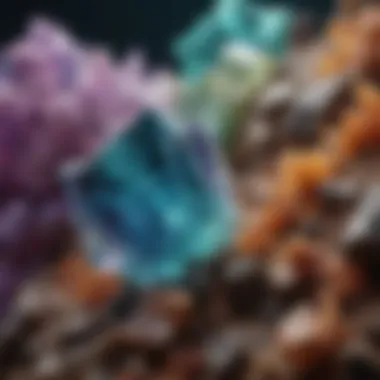
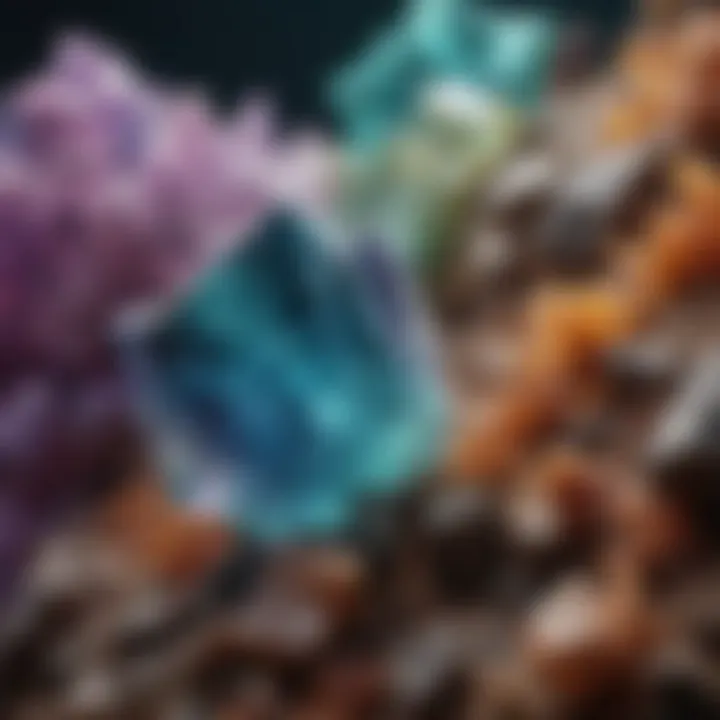
Intro
Fluorite is a gem that captivates many collectors and enthusiasts. It is renowned for its vivid colors and remarkable clarity. This mineral is not only aesthetically pleasing but also has significant historical and practical value. In this exploration, we will unravel the complexities surrounding fluorite gems, detailing their formation, historical significance, and applications in various fields.
History and Origins
Overview of Collectibles, Rocks, and Fossils
Fluorite has a rich history that intertwines with the broader context of collectible minerals and fossils. These gems have been sought after since ancient times, often utilized for their beauty and unique properties. For researchers and collectors, they represent a significant geological formation. The fascination with fluorite has evolved, reflecting both scientific interest and artistic appreciation.
Historical Significance and Cultural Impact
Fluorite garners respect in several cultures. Its vibrant colors were sometimes linked to spirituality and healing. The ancient Egyptians used fluorite in various ornamental objects. In the 19th century, it gained attention in Europe as a source of fluorine, an element essential in industrial processes.
"Fluorite's legacy is one that extends well beyond basic mineralogy, inspiring artisans and scientists alike."
Various famous fluorite deposits, such as those in China and Mexico, have contributed to its rich tapestry of use and significance. Many collectors seek fluorite not only for its mineralogical properties but also for the stories each specimen carries.
Identification and Classification
Guide to Identifying Rocks and Fossils
For collectors, identifying fluorite is vital. Fluorite can appear in diverse colors, including purples, greens, and yellows, each hue illuminating a different aspect of its chemical makeup. Spectators should look for its characteristic cubic crystal structure, which is a hallmark feature of this mineral. The hardness scale rates fluorite a four, making it softer than many gemstones but more durable than others.
Common Types and Variations
Fluorite can be classified into several types based on color and origin. Some notable types include:
- Purple Fluorite: Often seen in jewelry, this type holds a deep violet hue that many find enchanting.
- Green Fluorite: Frequently used in decorative carvings, green fluorite has a calm and soothing aesthetic.
- Blue and Yellow Fluorite: Less common, these types draw attention with their unique colors.
Each type of fluorite possesses distinct characteristics that appeal to different collectors, making research essential for identifying specific specimens.
This guide serves as a foundational understanding for those interested in the captivating world of fluorite gems, preparing both novice and seasoned collectors to appreciate the gem's nuances.
Prelude to Fluorite Gems
Fluorite gems have long fascinated collectors, geologists, and gem enthusiasts alike. The significance of understanding fluorite goes beyond its aesthetic value; it encompasses its unique chemical and physical properties, historical relevance, and varied applications in both art and industry. In this section, we will explore the importance of fluorite gems, their appeal among collectors, and why they occupy a noteworthy niche in the broader gemstone market.
Fluorite, scientifically known as calcium fluoride (CaF2), is renowned not only for its vibrant colors but also for its interesting luminescence. This mineral presents itself in a variety of hues including purple, blue, green, and yellow. The beauty of fluorite lies in this color diversity, making it a popular choice among gemstone collectors who are keen on striking visual pieces.
The Allure of Collecting Fluorite
Collecting fluorite gems can be rewarding due to their range of colors and forms. Additionally, due to their often unique crystal formations, each specimen tells a story of natural processes that have taken place over thousands, even millions, of years. Many collectors are attracted to the challenge of identifying specific varieties such as purple fluorite, blue fluorite, and even rarer forms. This creates a rich hobby for both novice and experienced collectors, providing them opportunities for education and discovery.
Benefits and Considerations
In terms of practical considerations, fluorite’s relative softness—rating between 4 and 5 on the Mohs scale—makes it less durable compared to other gemstones like diamonds and sapphires. This imperfection requires gem collectors to handle fluorite with care. However, this softness also lends itself to excellent carvability, allowing artisans to create intricate designs and sculptures that highlight the gem’s unique qualities.
Furthermore, beyond its use in jewelry and decorations, fluorite boasts applications in various industrial sectors such as metallurgy and ceramics. This versatility adds another layer of significance to its study, reinforcing the gem's multifaceted role in both culture and economy.
"Fluorite is not just a gemstone; it is an intersection of beauty, science, and industry, reflecting the complex interplay of nature and human endeavor."
Chemical Composition of Fluorite
Fluorite, with the chemical formula CaF₂, consists primarily of calcium and fluorine. This simple yet significant composition underlines many of the gem's key properties. Understanding the chemical makeup is crucial, not just from a gemological perspective but also for its broader applications in various industries. Fluorite offers a glimpse into mineral chemistry, which can be fascinating for both collectors and general enthusiasts alike.
Elements and Compounds
The two main elements in fluorite are calcium and fluorine. Calcium, a relatively common mineral found in many forms, contributes to fluorite's physical properties, including the gem's hardness and cleavage. Fluorine, on the other hand, is a halogen and gives fluorite its unique coloration and luster. The presence of trace elements can also introduce color variations, making each specimen quite unique.
Key components of fluorite include:
- Calcium (Ca): Helps define the crystal structure and stability.
- Fluorine (F): Affects the optical characteristics and overall appearance.
- Trace Elements: Elements like iron, manganese, and cerium can influence color and properties, often desired by collectors.
Understanding these elements allows collectors to appreciate not only the beauty of fluorite but also its role in various applications, from metallurgy to ceramics.
Crystalline Structure
The crystalline structure of fluorite is cubic, which is significant in gemology. Its symmetry results in distinct optical effects desirable for lapidary arts. When viewed under polarized light, fluorite exhibits a notable phenomenon called double refraction. This occurs because of the arrangement of calcium and fluorine ions within the crystal lattice.
Key characteristics of fluorite's crystalline structure include:
- Regularity: The cubic form allows for uniformity in crystals, affecting how light interacts with them.
- Cleavage: Fluorite has perfect octahedral cleavage, which allows it to be split easily in specific directions, influencing cutting techniques in jewelry.
- Fluorescence: In some cases, fluorite can fluoresce under ultraviolet light, which is a direct result of its crystalline arrangement.
Physical Properties of Fluorite
Understanding the physical properties of fluorite is essential for anyone interested in this captivating gem. The properties not only inform collectors about its care and handling but also contribute to its appeal in both the jewelry market and scientific communities. Fluorite’s unique characteristics influence its desirability and functionality, particularly in gem cutting and crafting. Details such as hardness, durability, and color variations play a significant role in how this gem is perceived and used.
Hardness and Durability
Fluorite has a Mohs hardness of 4, indicating it is softer than many other gemstones. This soft characteristic means that it is more susceptible to scratches and damage than harder stones. Therefore, when handling or setting fluorite in jewelry, caution is crucial.
Considerations for Collectors:
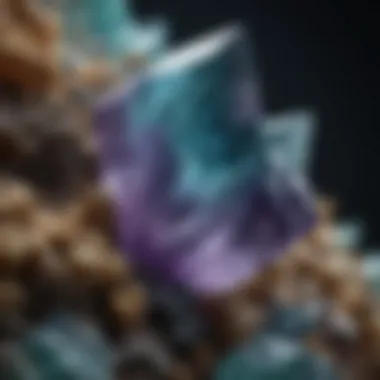
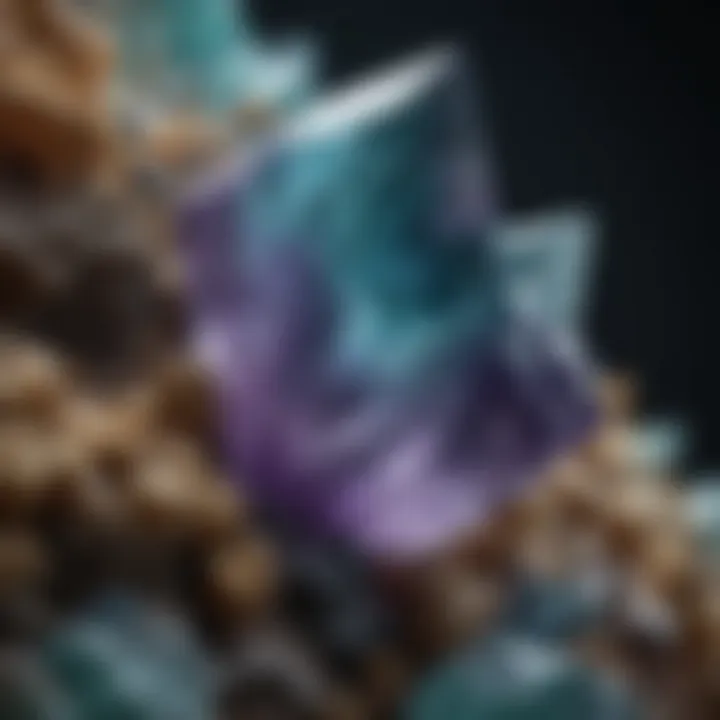
- Fluorite gems should be protected from harder materials.
- Store them separately from other gemstones to avoid abrasion.
- Use soft cloths for cleaning, as harsh chemicals can damage the surface.
- Avoid exposure to extreme temperature changes, which can lead to fractures.
These considerations emphasize the need for diligent care when incorporating fluorite into jewelry or displays.
Color Variations
One of the most intriguing aspects of fluorite is its vivid color variations. Fluorite can be found in colors ranging from green and purple to blue and yellow. Each hue stems from the presence of trace elements during its formation.
- Green: Often associated with natural sources, green fluorite is particularly popular among collectors.
- Purple: Known as "blue john", purple fluorite can be striking and is highly sought after for decorative pieces.
- Clear: Colorless fluorite possesses a unique clarity that is visually appealing and desired for certain applications.
- Yellow to Brown: These rarer colorations can result from the presence of iron.
The depth and tone of these colors can impact the perceived value of the gem. Fluorite's diverse palette ensures its relevance in modern jewelry, where color plays a pivotal role in design.
Understanding fluorite’s physical properties enhances the appreciation for its beauty and complexity, making it a worthy addition to any gem collection.
Formation and Occurrence
Understanding the formation and occurrence of fluorite gems provides essential context within the broader discussion about these unique minerals. Fluorite forms through specific geological processes, often in a range of environments which can significantly affect its characteristics. Knowing how these gems materialize allows collectors and enthusiasts to appreciate not only their beauty but also their geological history. Different locations also yield various types of fluorite, which contributes to its appeal in both the collector's market and scientific communities.
Geological Formation Processes
Fluorite typically forms in hydrothermal environments where hot, mineral-rich water moves through rocks. This process often occurs in veins, which are narrow fractures filled with minerals. During the cooling stages of these solutions, fluorite crystallizes. It can also develop from the metamorphism of limestone rocks.
This geological aspect is key as it determines the purity and coloration of the fluorite. The conditions under which fluorite crystals grow can influence their clarity and color. Understanding these processes can help collectors identify more desirable specimens.
Additionally, regions with abundant calcium and fluoride, such as certain limestone deposits, offer optimal conditions for fluorite formation. Thus, the location and nature of geological activities play a critical role in the quality and availability of fluorite gems.
Global Locations for Fluorite
Fluorite is found across several countries, with notable deposits in regions known for their geology. These global occurrences have shaped its collection and commercialization.
Notable Deposits
Notable deposits of fluorite can be found in places such as the Illinois fluorspar district in the USA and the Minerva mine in Kentucky. These locations are celebrated for their rich concentrations of high-quality fluorite, often exhibiting an array of vibrant colors, including purple, green, yellow, and even clear variations.
The unique feature of these deposits is the diversity of hues and the size of the crystals, making them a favored choice for collectors. The rich aesthetic appeal contributes significantly to their market demand. However, mining in these areas must be managed properly to preserve these natural resources.
Mining Practices
Mining practices for fluorite vary significantly by region and can impact both the quality of the gems and the environment. In regions like the USA and Mexico, where fluorite mining is prominent, methods range from traditional hand-mining to more modern machinery. These varied techniques can yield different qualities of fluorite, affecting its value in the market.
A key characteristic of mining practices is the sustainability aspect. Ongoing efforts to adopt environmentally friendly practices are crucial, given the potential for mining to disrupt local ecosystems. Furthermore, mining accidents can lead to loss and waste of valuable minerals. Therefore, innovations in mining technology and practices can empower collectors to access exceptional specimens while respecting ecological balance.
"Sustainable mining ensures that the beauty of fluorite can be appreciated for generations to come."
Through exploring these topics, readers gain insight into where fluorite comes from, how it is harvested, and what makes certain varieties more prized than others. This knowledge enhances the appreciation of fluorite gems and informs better collecting practices.
Historical Significance of Fluorite
Fluorite has played a notable role throughout history, serving both practical and cultural purposes. This mineral, known for its colorful and diverse appearance, has captured the attention of various civilizations over the centuries. Understanding its historical significance provides depth to its current value and relevance in today’s gemological and cultural landscapes.
Cultural Uses Through Time
Fluorite has been used as a material in numerous cultural contexts. Ancient cultures recognized its aesthetic appeal and practical uses. In China, fluorite was carved into seals and ornaments. These artifacts demonstrated not only the skill of the artisans but also the cultural reverence for the mineral. This showcases how fluorite served a dual purpose as both decoration and a functional item.
The Middle Ages saw further exploration into fluorite’s metaphysical properties. It was often included in talismans, believed to provide protection and enhance intuition. This era highlighted the shift from purely decorative use to a blend of art and spiritual belief, solidifying its place in both everyday life and cultural practices.
In regions like Europe, fluorite was also utilized in early scientific studies. Its unique properties made it a subject for experimentation and exploration in laboratories. The color spectrum of fluorite opened doors for researchers examining the properties of light and crystallography, leading to significant advancements in these fields.
The Gem in Ancient Civilizations
Fluorite's importance was not limited to practical uses. Several ancient civilizations attributed significant value to the gem. In Egypt, for instance, fluorite was used to produce stunning jewelry for the elite. Its vibrant colors and ability to take on various forms made it a favored choice among jewelers.
The Romans also recognized fluorite, using it for ornamental purposes and construction. Roman engineers valued fluorite for its ability to be worked into fine, smooth shapes. This made it a popular choice for decorative features in architecture.
Furthermore, the ancient Greeks linked fluorite to the god Apollo, associating the mineral's clarity and brightness with guidance and foresight. Such uses reflect a society's relationship with nature, where materials like fluorite transcended their physical forms to embody cultural and spiritual significance.
"Fluorite, beyond its beauty, illustrates humanity’s evolving relationship with the earth’s minerals throughout history."
Fluorite in the Gemstone Industry
Fluorite holds a unique position in the gemstone industry. Its vibrant colors and crystal forms make it alluring not only to collectors but also to gemstone artisans. Understanding the nuances of fluorite's role within this sector is essential for anyone interested in gemstones.
Gemcutting Techniques
The beauty of fluorite is largely realized through skilled gemcutting techniques. Due to its relatively low hardness, measuring between 4 and 5 on the Mohs scale, fluoriite can be challenging to cut. Balance is critical; excessive pressure during cutting can lead to fractures.
Some popular cuts for fluorite include:
- Cabochon: This typical style helps maximize the stone's color and beauty. It offers smooth, rounded surfaces, giving a soft appearance.
- Faceted: Although more difficult, faceting enhances the stone's sparkle and brilliance. It involves careful calculation of angles to achieve the best light refraction.
Each technique requires a deeper knowledge of the stone's unique properties, making professional training valuable. It ensures that each gem is showcased to its fullest potential.
Market Value and Demand
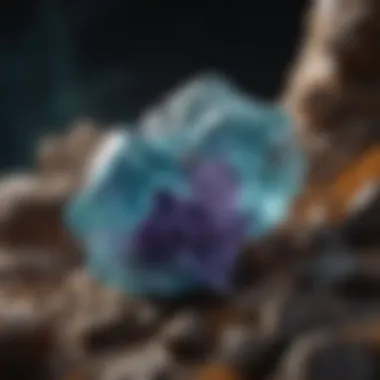
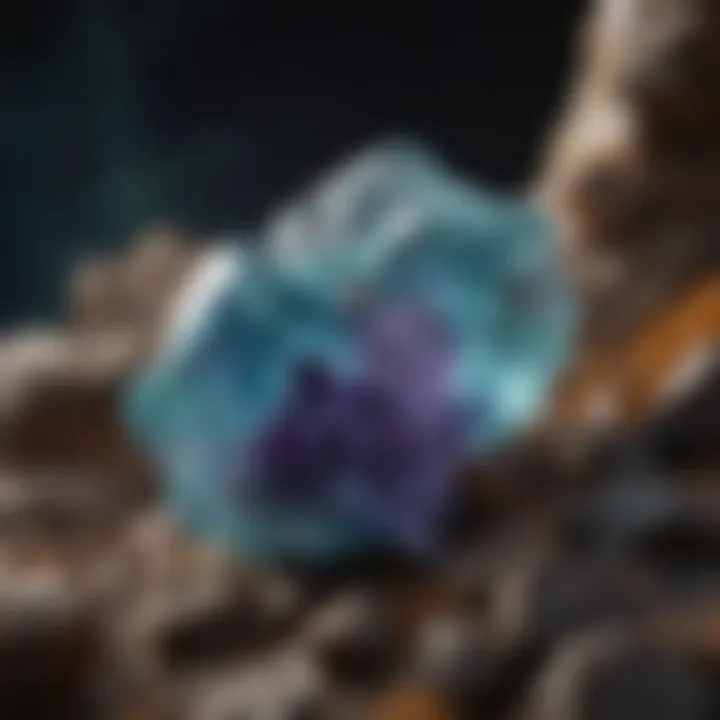
Fluorite's market value fluctuates, and several factors contribute to this dynamic. Its rarity in certain colors, like deep purple or multicolored varieties, can significantly impact its price. Furthermore, the demand for finely crafted pieces among collectors influences market trends.
- Quality and Clarity: Higher quality stones, free from visible inclusions or blemishes, fetch better prices. Clear, vibrant stones are highly sought after.
- Collector Interest: The growing interest in unique and colorful gemstones drives collectors to seek out fluorite. Special editions or notably cut pieces can command premium prices.
"The value of fluorite gems remains contingent on shifting market sentiments, production rates, and craftsmanship."
Fluorite's versatility, coupled with its aesthetic appeal, ensures that it occupies a significant niche within the gemstone market. As awareness grows, possibly driven by trends evidenced in collector communities on Reddit or Facebook, the industry may see increased attention directed towards this remarkable mineral.
Identification of Fluorite Gems
Identifying fluorite gems is essential for collectors and enthusiasts alike. Knowing how to accurately assess these stones ensures authenticity and value. In the vast market of gemstones, knowledge of identification methods distinguishes true collectibles from inferior imitations. Moreover, proper identification allows for understanding their unique attributes and potential uses. The ability to discern fluorite enhances the appreciation of its beauty while providing crucial information for any potential investment.
Visual Characteristics
Fluorite exhibits distinctive visual traits that significantly aid in its identification. It typically presents in vibrant colors, ranging from purple to green, and can even appear in yellow, blue, or colorless forms. The characteristic clarity and luster of fluorite make it easily recognizable among other gems.
Key traits include:
- Transparency: Well-formed fluorite is usually transparent or translucent. This quality can help differentiates it from other gems.
- Color Zoning: Fluorite often displays zones of different colors, which are a good indication of its quality and nature.
- Shape: Generally, fluorite crystals form in cubic shapes, which is part of its identity.
These traits are vital for identifying genuine fluorite, ensuring that collectors can confidently assess their stones.
Utilizing Tools for Identification
Gaining a precise identification often requires specialized tools. Among the most useful are refractometers and spectroscopes. Each tool has its unique strengths and assists in confirming the gem's properties effectively.
Refractometers
Refractometers are invaluable in gemology, providing detailed insights into the refractive index of minerals.
- Key Characteristic: Refractometers measure how light bends as it passes through a gem. This information helps in determining the identification of a gemstone.
- Benefits: They are precise and can provide a quick assessment, making them a popular choice among gem enthusiasts and professionals.
The unique feature of a refractometer is its ability to evaluate transparency and clarity, which are crucial when examining fluorite. A limitation is that refractometers may require some training to use effectively, particularly for accurate readings.
Spectroscopes
Spectroscopes introduce another layer of analysis for identification purposes. They analyze light wavelengths emitted or absorbed by a gem.
- Key Characteristic: Spectroscopes show colors and bands of light, thus revealing certain elements within the gem.
- Benefits: They are excellent for distinguishing fluorite from similar-looking stones.
The unique feature of a spectroscope lies in its ability to detect specific chemical compositions through spectral patterns. Limitations include the need for a controlled environment, as ambient light can alter readings.
"Knowledge is power, especially in the world of gem collecting."
The importance of accurate identification cannot be overstated. It informs collectors about the authenticity and value of their gems. By utilizing the right visual characteristics and tools, one can ensure they appreciate the unique qualities of fluorite correctly.
Care and Maintenance of Fluorite
Proper care and maintenance of fluorite gems ensures their longevity and vibrancy. Fluorite, while beautiful, is relatively softer compared to other gemstones, which makes it susceptible to scratches and damage. Understanding the significance of maintenance not only preserves the gem's aesthetic appeal but also enhances its value for collectors. Not taking proper care can lead to irreparable damage, reducing the gem's allure and diminishing its market value. Thus, this section highlights essential techniques for cleaning and storing fluorite gems to protect their integrity.
Cleaning Techniques
When it comes to cleaning fluorite, gentle methods are crucial. The stone can react negatively to harsh chemicals and abrasive substances, leading to permanent damage. Here are some effective techniques for cleaning fluorite:
- Use warm soapy water: Mix mild dish soap with warm water. Soak a soft cloth in this solution and gently wipe the surface of the fluorite stone. Avoid scrubbing, as this may scratch the surface.
- Soft brush tool: A clean, soft-bristled toothbrush can be a useful tool for cleaning intricate details or corners of the gem. Always use light pressure to prevent any scratches.
- Avoid ultrasonic cleaners: These devices can damage fluorite due to the vibrations and potential for heat exposure. Stick to manual cleaning methods to ensure safety.
Always dry the gem thoroughly using a soft, lint-free cloth after cleaning. This prevents water spots from forming. It is also advisable to limit exposure to sunlight during cleaning endeavors, as prolonged sunlight can fade the stone's vibrant colors.
Storage Recommendations
Storage plays an equally important role in maintaining the quality of fluorite gems. Proper storage minimizes the risk of scratches or damage. Consider the following recommendations for storing your fluorite:
- Use soft pouches or cloth bags: Each piece should be stored in individual soft cloth pouches. This prevents gems from rubbing against each other, which can lead to scratches.
- Avoid plastic containers: These can trap moisture, which may cause the stone to develop cloudiness over time. Instead, opt for wooden or fabric-lined boxes.
- Keep in a stable environment: Store fluorite gems in a cool, dry place away from direct sunlight and extreme temperature fluctuations. Changes in humidity and temperature can affect the stone’s physical properties.
Fluorite in Healing Practices
Fluorite gems hold a notable place in the realm of healing practices. Many enthusiasts and practitioners believe in their metaphysical properties. This section explores how these beliefs shape the use of fluorite in various healing contexts. Understanding these practices requires both a grasp of the underlying concepts and an awareness of the claims made about their effectiveness.
Metaphysical Beliefs and Uses
Fluorite is often associated with clarity and focus. Practitioners suggest that it helps in enhancing mental clarity and concentration. Many believe that holding or meditating with fluorite can cleanse negative energies, promoting a more positive emotional state. Furthermore, there are various claims suggesting that fluorite can aid in decision-making and problem-solving processes, appealing to those seeking guidance in their life choices.
Many cultures employ fluorite for specific purposes that vary with color. For example, purple fluorite is linked to spiritual growth, while green fluorite may be used for its purported detoxifying properties. The presence of multiple colors within a single specimen makes fluorite unique and adaptable for varied healing intentions. Some people include fluorite in crystal healing layouts, positioning it alongside other stones to amplify their effects.
Scientific Evidence Behind Claims
Despite the widespread use of fluorite in metaphysical practices, scientific evidence supporting these claims remains limited. Research in the field of mineral therapy has not definitively proven that fluorite possesses any unique healing properties.
Studies often focus on the geological aspects and physical properties of fluorite, rather than its metaphysical implications. Most of the scientific community regards claims about healing as anecdotal, lacking empirical support.
While enthusiasts advocate for its psychological benefits, it is essential to approach these claims with a critical mindset. Practitioners suggest that the calming colors of fluorite can enhance mood and promote a sense of peace, yet such effects are likely subjective. Using fluorite should complement, not replace, traditional medical advice or treatment.
In summary, while there is a rich tapestry of beliefs surrounding the use of fluorite in healing, the scientific community encourages further research to validate these claims. Interest in fluorite continues to grow, pushing both collectors and practitioners to explore its complexities.
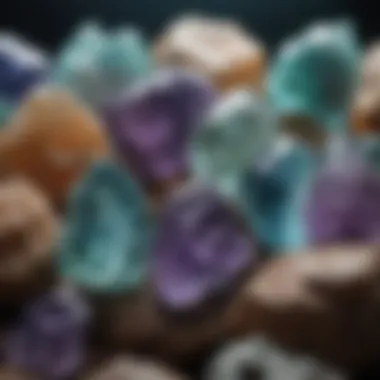
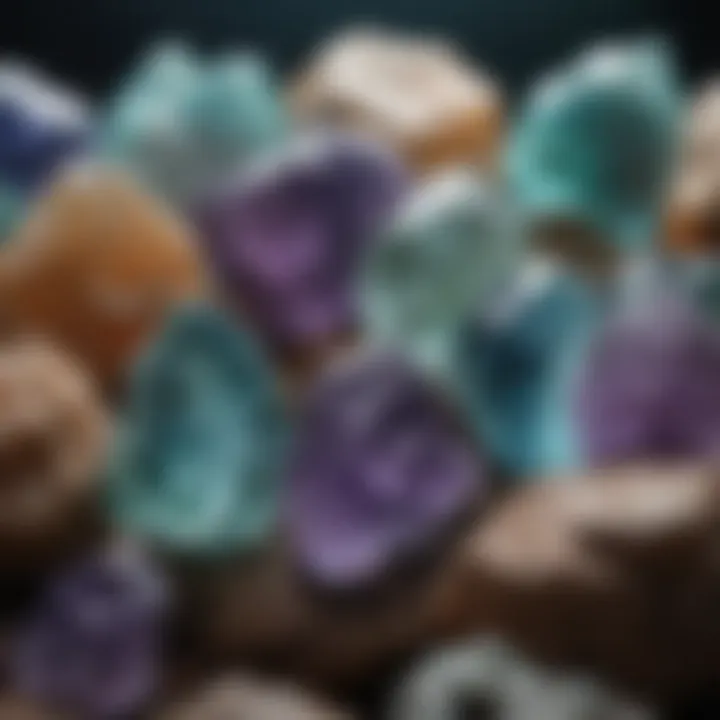
Collecting Fluorite Gems
Collecting fluorite gems presents both a rewarding hobby and a serious pursuit for many enthusiasts. The allure of fluorite lies in its captivating colors and unique crystal formations. Fluorite is not just a visually appealing mineral; it holds significant geological value. For collectors, understanding the various types and sources of fluorite can enhance their collection and appreciation.
Tips for New Collectors
Starting a collection of fluorite can be both exciting and overwhelming. Here are some practical tips for new collectors:
- Research Before You Buy: Understanding the different types of fluorite, such as green, purple, or blue varieties, will help you make informed decisions. Look for information on geological formation and color variations.
- Visit Gem Shows: Attend local gem and mineral shows. These events often feature various specimens for sale, providing opportunities to buy directly from vendors. Interacting with sellers can also give you insights into the gems' origins.
- Examine Authenticity: Make sure to check the authenticity and quality of fluorite specimens. Some can be treated or enhanced. Ask for certifications or provenance if available.
- Keep Records: Maintain records of each piece you acquire. Documenting where and when you found or purchased your fluorite will not only enhance the value but deepen your connection to each gem.
Joining Collector Communities
Becoming part of collector communities can significantly enrich your experience. Engaging with fellow enthusiasts allows for knowledge sharing and opportunities for trading:
- Online Forums: Websites like Reddit feature discussions about fluorite where collectors share tips, insights, and latest finds. Joining such forums can be a great way to connect with others who share your passion.
- Social Media Groups: Explore platforms such as Facebook to find groups dedicated to mineral and gemstone collecting. These groups often provide a platform for showcasing collections and potential trading opportunities.
- Local Clubs: Seek out local mineral clubs or societies. These groups might organize field trips to collecting sites, workshops, and social events. Such gatherings often foster collaboration and learning about collecting, preservation, and even the science behind gems.
Engaging in collecting fluorite gems not only adds beauty to your collection but also allows for a deeper understanding of mineralogy and geology.
Fluorite in Art and Culture
Fluorite holds a special place in the realm of art and culture. Its vibrant colors and clarity make it a favored material for artists and jewelers alike. The gem's aesthetic appeal goes beyond mere decoration; it also serves as a medium for expression and storytelling. Artists use fluorite not only for its physical beauty but also for the meanings and emotions associated with it.
Artistic Representations
Throughout history, fluorite has found its way into a variety of artworks. Sculptures and intricate carvings showcase the gemstone's alacrity in reflecting light and color. Many artisan work with it in respective cultures, producing unique pieces that blend tradition and modern aesthetics. For instance, in China, skilled craftsmen have historically made elaborate carvings from the stone, turning the mineral into symbolic representations of nature and spirituality.
Aside from physical sculptures, fluorite has also inspired painters and designers. The colors of fluorite, shifting from purples to greens, can evoke different emotions and themes. Artists often draw on these qualities, integrating them into their work, which demonstrates the gem's broader cultural significance. Observing how fluorite appears in diverse artistic mediums allows one to appreciate the gem's role in enhancing human creativity.
Influence on Modern Jewelry
In contemporary jewelry, fluorite emerges as both a trendy and significant choice. Jewelers appreciate its wide spectrum of colors, offering variety in collections and designs. Fluorite's vibrant hues allow for innovative jewelry combinations, reflecting trends while adhering to cultural significance. The popularization of fluorite in jewelry aligns with a greater inclination towards unique and less conventional gemstones, as buyers increasingly seek pieces that tell their individual stories.
Moreover, modern jewelers employ advanced techniques to cut and polish fluorite, emphasizing both its beauty and durability. This mastery of craft ensures that fluorite not only serves a decorative purpose but also stands the test of time in functionality.
A relevant aspect of fluorite in jewelry is that it attracts a specific demographic, often collectors and enthusiasts who appreciate its rarity and unique properties.
"Fluorite's multicolored nature embodies the spectrum of human emotion, making it a profound choice in artistic and jewelry design."
Environmental Considerations
Understanding the environmental implications of fluorite mining and usage is crucial in today's ecological landscape. As demand for fluorite increases, so do concerns regarding the sustainability of mining practices and the long-term conservation of fluorite deposits. This section discusses the need for responsible mining strategies and effective conservation efforts to preserve this valuable mineral for future generations.
Sustainability in Mining Practices
Sustainable mining practices are essential to minimize environmental impact. This involves adopting methods that reduce damage to ecosystems, limit carbon emissions, and ensure the well-being of surrounding communities. Companies are now exploring ways to implement cleaner technologies that decrease pollution during the extraction process.
For example, water management techniques can reduce the strain on local water supplies. Implementing recycling processes during mining can also cut down the need for new raw materials. Furthermore, training workers on environmental best practices promotes a culture of sustainability within the industry.
Conservation of Fluorite Deposits
Conservation efforts are equally important for maintaining fluorite deposits. Overexploitation can lead to depletion, driving up prices and threatening the availability of this gem for future collectors and enthusiasts. Establishing protected areas where mining is restricted helps to preserve natural habitats and maintain biodiversity.
Additionally, ongoing research into the geological formations where fluorite is found can identify new methods for extraction that are less invasive. Encouraging responsible collecting habits among enthusiasts is vital. Educating collectors about the value of conservation creates a community that values sustainability and can influence market demand positively.
"Protecting fluorite deposits is not just about preserving a gem; it is about ensuring ecological balance for future generations."
By focusing on sustainable practices in mining and conservation efforts, the industry can secure a future where fluorite remains accessible and appreciated.
The interplay between environmental responsibility and the allure of fluorite gems highlights the need for ongoing dialogue and action within both the industry and collector communities. This careful approach allows us to enjoy the beauty of fluorite without compromising our planet.
Future Trends in Fluorite Gemology
As the gemstone industry evolves, it is vital to recognize and understand future trends in fluorite gemology. These trends encapsulate the advancements in technology, market demand, and sustainable practices that shape how collectors and buyers value fluorite. By examining these trends, stakeholders can better navigate the emerging landscape of fluorite gems.
Innovations in Synthetic Fluorite
Synthetic fluorite has gained prominence in recent years. This is due to its cost-effectiveness and the ability to produce flawless stones. Innovations in the production process allow for the creation of synthetic fluorite that mimics the appearance of natural minerals without including any impurities. This aspect is particularly appealing to collectors who seek vibrant colors and clarity.
Moreover, the market for synthetic stones is growing. Many consumers prefer synthetic because they are typically more affordable and ethically sourced. This trend contributes positively to the industry by reducing the pressure on natural deposits.
The technology behind creating synthetic fluorite is continuously advancing. New methods aim for increased brilliance and unique coloring, which makes them attractive for jewelry designers. Those who appreciate the aesthetics without compromising the environment may find synthetic fluorite a valid alternative.
Emerging Market Insights
The marketplace for fluorite gems is expanding, driven by modern trends in consumer behavior and awareness of sustainable practices. Collectors are becoming increasingly educated about the properties and value of fluorite. They seek unique specimens that not only appeal aesthetically but also have interesting provenance.
Research indicates an increase in interest from younger demographics. Millennials and Gen Z consumers are amplifying interest in naturally occurring gems. These groups value sustainability, leading to a higher demand for ethically sourced fluorite. As a result, miners and retailers are adjusting their practices to meet these preferences.
Additionally, online platforms, such as Reddit or trading websites, are influencing how collectors purchase and share their findings. Increased information exchanges help in establishing fair prices and understanding market trends. Furthermore, with social media’s power, influential collectors are motivating a new wave of enthusiasts eager to explore and invest in fluorite gems.
End
The conclusion of this article highlights the diverse and significant aspects of fluorite gems, underscoring their relevance not just to collectors but to a broader audience interested in geology and mineralogy. Fluorite, with its fascinating variety of colors and unique properties, stands as a captivating subject within the realm of gemstones.
Understanding the importance of fluorite begins with its remarkable visual appeal. The different shades of fluorite, ranging from vibrant greens to deep purples, make it a sought-after mineral for jewelry and decoration. This natural beauty is complemented by its distinct crystal form, which can be appreciated in exhibits or collections.
Beyond aesthetics, the historical significance of fluorite cannot be overlooked. Throughout centuries, cultures have utilized fluorite not just as a gemstone, but for its supposed metaphysical properties. This aspect appeals to both collectors who seek to understand the gem's past and those interested in its cultural narratives.
The mining and environmental considerations surrounding fluorite also warrant attention. Recognizing sustainable practices in the extraction of fluorite can guide future efforts to ensure that this resource remains available for upcoming generations. Such awareness can also lead to better conservation of fluorite deposits around the world.



